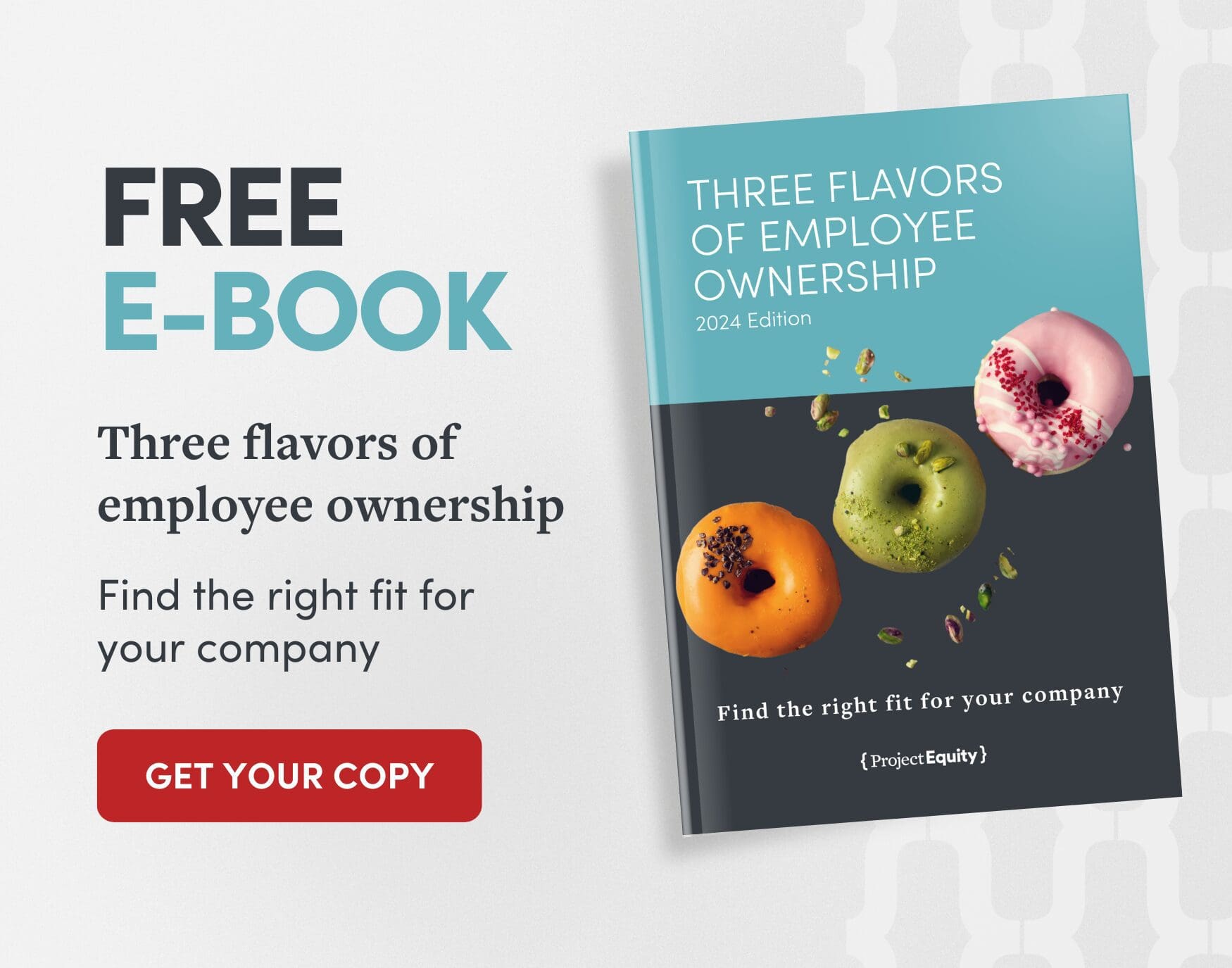Top 11 employee ownership trends for 2025
- Michelle Philippon
2024 was a year of exciting changes and opportunities in the employee ownership (EO) world, from convening on worker-owned businesses at the White House to more employee-owners reaping the benefits of their transition to being employee-owned.
What will the rest of 2025 look like for EO?
To get answers, I talked to internal and external EO experts. Here’s what they had to say.
Worker cooperatives will have their moment (globally)

On June 19, 2024, the United Nations General Assembly declared 2025 as the International Year of Cooperatives (IYC), recognizing the crucial role that worker cooperatives play in sustainable development. A worker cooperative is a company owned and controlled by—and for the benefit of—the people who work there.
Under the theme “Cooperatives Build a Better World,” IYC 2025 highlights the global impact of cooperatives and their contributions across social, economic and environmental dimensions. It demonstrates how cooperatives drive progress toward the UN Sustainable Development Goals by 2030. The theme also reflects the cooperative model’s unique ability to promote inclusive growth and strengthen community resilience.
The Committee for the Promotion and Advancement of Cooperatives—a coalition of global public and private institutions—will serve as the official host of IYC 2025, advocating for cooperative enterprises as key players in sustainable development.
The objectives of IYC 2025 are to:
- Raise awareness: Showcase how cooperatives contribute to sustainable development.
- Promote growth: Strengthen the cooperative ecosystem and entrepreneurial opportunities.
- Advocate for support: Encourage policies and legal frameworks that enable cooperatives to thrive worldwide.
- Inspire leadership: Foster purposeful leadership and engage youth in the cooperative movement.
EO will be applied by government and economic development leaders

“As government and economic development leaders look for effective strategies to preserve resilient local economies and build quality jobs—ones that weather economic shifts and downturns—I believe more and more leaders will add employee ownership to their toolkit and begin unlocking the power of EO in their communities. In a time where local policy can sometimes be polarizing, supporting local businesses to explore and transition to employee ownership is a rare win for business owners, workers and economic development leaders,” said Sarah McBroom, the director of ecosystem development at Project Equity.
Julian S. McKinley, the co-executive director for partnerships and growth at the Democracy at Work Institute (DAWI), echoed this, explaining how he anticipates seeing more place-based ecosystem growth in the U.S. “The federal government’s crackdown on spending means cities, counties and states will need to play a bigger role in supporting their local economy,” he said. “For the long-term, I anticipate an increase in local policy and resources supporting EO.”
Here are some examples of recent local EO legislation:
- Colorado – HB25-1021: A bipartisan bill introduced in the Colorado House of Representatives aims to expand incentives for employee ownership. Currently, the state offers tax credits for companies adopting Employee Stock Ownership Plans (ESOPs), worker cooperatives, Employee Ownership Trusts (EOTs), or similar structures where employees hold at least 20% equity. Beginning in 2027, the bill would introduce a capital gains tax exclusion for sellers to these plans and provide a federal income tax deduction of up to $1 million annually for worker cooperatives. It would also expand the existing tax credit program for businesses transitioning to employee ownership.
- Indiana – Senate Bill 175: Authored by Senator Shelli Yoder, this bill proposes establishing an Employee-Owned Business Resource Center to administer a revolving loan program and fund to support employee ownership transitions.
- Indiana – House Bill 1038: Introduced by Representative Jake Teshka, this bill would require the state treasurer to create a financing program for companies transitioning to employee ownership via ESOPs. The treasurer could partner with financial institutions by placing certificates of deposit (CDs) at below-market rates, allowing banks to offer reduced-interest loans to companies adopting employee ownership structures.
National legislation will still play a part
“The new Administration could significantly influence the overall business environment in the United States assisting in EO creation,” said Kim Blaugher, the executive director, Charles Chang, a senior consultant, and Selina Yang, a consultant at the Beyster Institute at UC San Diego’s Rady School of Management. “We also anticipate greater collaboration from the new administration and regulatory agencies, such as the DOL and IRS, to support the expansion of employee ownership models like ESOPs. This will create more opportunities for employees to achieve their financial and social goals.”
Whether this includes the reintroduction of the Employee Equity Investment Act (EEIA), which was first introduced in 2023, has yet to be seen, but it’s possible it could be reintroduced this year.
EO will be necessary to help more workers access the American Dream

“2025 is a year of egregious wealth inequality,” said Michael Moyer, an employee ownership business consultant at the Beyster Institute. “The bottom 80% of the population in the United States owns just 8% of the wealth. Meanwhile, the wealthiest three Americans have more than 50% of the wealth in the nation. Employee ownership can help to stem this overwhelming tide of inequality.”
American workers are hurting. According to the U.S. Department of Treasury, housing costs have been rising faster than incomes since 2000. Many workers have fallen behind. The good news is that employee ownership can help build more equity with American workers and business owners alike. EO can help employees build wealth, strengthen local economies and increase businesses’ cash flows.
Worker cooperatives may unionize

“Worker cooperatives are starting to see the advantages of unionizing, thereby combining the principles of collective bargaining power and worker ownership,” said Hope Williams, the director of legislative advocacy at the Sustainable Economies Law Center. “The union coop model amplifies the voice of the workers, which allows them to engage as members while ensuring fair wages, better benefits and workplace protections—all while still maintaining democratic control.
“With additional support and advocacy, unions create a balance of internal governance and external accountability,” she continued. “The generated interest in this model stems from a need for stronger worker protections. Unions have begun to look for new ways to support worker-led businesses.”
The EO community will collaborate even further

“In 2025, we anticipate increased collaboration within the employee ownership community, including coops and ESOPs, under the common goal of expanding and improving EO models,” said Kim, Charles and Selina. “Working together and promoting an ownership culture has been a growing interest among various organizations in the community.”
Businesses will offer various forms of equity compensation to their employees

“Many of the companies we have worked with have adopted multiple forms of equity compensation, including the use of stock appreciation rights (SARs) and other equity (or synthetic equity) instruments combined with other programs such as profit-sharing, all with the goal of achieving greater benefits for employees,” Kim, Charles and Selina explained. “We see this trend continuing in 2025, either to incentivize the creation of more employee-owned companies or to sustain them.”
The Silver Tsunami will drive the adoption of EO

Across the U.S., 2.9 million businesses have owners that are aged 55+. This Silver Tsunami of retiring business owners “has been a significant demographic force driving business owners to adopt employee ownership models like ESOPs,” shared Kim, Charles and Selina. “We anticipate this trend will continue to play a key role in shaping the market.”
As business owners recognize the many advantages of transitioning their business to broad-based employee ownership as an exit strategy, more will explore EO options such as ESOPs, coops and EOTs so they can preserve their legacy, motivate their employees and keep their business rooted in their local communities.
Private equity may play a bigger role in the EO space

“2025 may also be the year that private equity will expand its presence in the EO community,” Kim, Charles and Selina said. “Initiatives from KKR (Kohlberg Kravis Roberts), for example, have provided great visibility about EO in the mainstream media, and it may attract other players to join and grow the industry.”
Pete Stavros, a partner and the co-head of global private equity at KKR, started incorporating ownership and profit-sharing into his KKR acquisitions. Pete then founded Ownership Works, a nonprofit organization that partners with companies and investors to provide all employees with the opportunity to build wealth at work, and Expanding ESOPs, a coalition that sees ESOPs as a tool to create meaningful opportunities for workers.
We’ll see diversified capital providers for EO

Julian explained that he anticipates seeing more diversified capital providers supporting EO transitions.
“Conversions are no longer needing to be argued for,” he stated. “People understand the value. Now it is about expanding use and access, and more traditional capital providers are looking to support EO.”
Want to know more about capital for EO transitions? At Project Equity, we offer two capital solutions to fund them:
- The national Employee Ownership Catalyst Fund supports businesses throughout the U.S. that want to transition to employee ownership and need capital to finance the transition and transaction.
- Accelerate Employee Ownership supports businesses to transition to employee ownership.
EO awareness will continue to spread

“Employee ownership has been widely and positively embraced by the general public,” Kim, Charles and Selina said. “We anticipate growing awareness of this concept, which will likely lead to increased interest.”
As mentioned before, private equity’s ventures into EO have helped propel the spread of information about EO to the public. “I am hopeful that the trend of employee ownership becoming a more frequent topic of discussion in the mainstream media continues,” said Steve Storkan, the executive director at the Employee Ownership Expansion Network (EOX).
Trust conversions will grow

EOTs use the Perpetual Purpose Trust (PPT) structure to protect the mission and operations of the company, as well as to benefit current and future employees “in perpetuity.” Company shares (equity) are held and owned by the PPT.
“In 2025, I expect to see the continuation of the rise in conversions to Purpose Trust Ownership and Employee Trust Ownership,” said Courtney Kent, a senior client services manager at Project Equity. “PPTs and EOTs are highly flexible forms of employee ownership that provide valuable benefits to employees and lock in the Purpose of a business in perpetuity. The PPT structure can work across a variety of industries and company sizes.
“I predict that in 2025, Project Equity will continue seeing a rise in companies interested in serving a greater purpose beyond shareholder profit maximization,” Courtney continued. “Our clients care about the legacy they leave on their employees, supply chains, consumers, communities and environment. More and more businesses will follow this example, seeking to establish legal structures which lock in these values over the long run.”
More EO resources
As you’ve read, EO has a lot of promising things on the horizon for the rest of 2025. We’re excited for the road ahead!
For more intel on EO, dive into:
- What the employee ownership pipeline looks like.
- Our e-book about the three flavors of employee ownership.
- This client impact report to see how EO delivers real economic benefits.
About the author
Michelle Philippon is the content manager at Project Equity, where she helps drive the organization’s storytelling by crafting and distributing content that showcases the power of employee ownership. A creative and results-driven content marketer, Michelle loves working with internal and external SMEs to provide useful insights to help small business owners, business advisors and economic developers achieve their goals.



